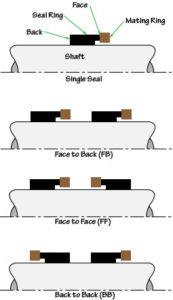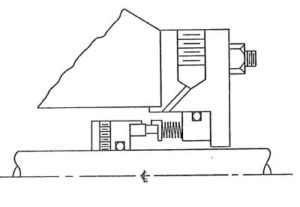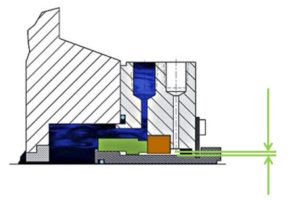The term “Engineered Seal” is widely misused and misunderstood with respect to API 682. Let’s see how this came about.
API 682 imposes a wide range of design details for mechanical seals including materials, clearances, and design elements; however, it is not all inclusive of all seals and services. The 4th Edition Taskforce believed that this subset of details was prudent for seals which would be applied within the scope of the standard. At the same time, the Taskforce recognized that at higher pressures, temperatures, speeds, or sizes the design details of the standard might be inappropriate for the intended application. Outside of this scope, the seal OEM is permitted, even encouraged, to deviate from the prescribed requirements and to “engineer” a seal with specific characteristics that are appropriate for the specific out-of-scope application. By definition, this special seal will then not fall into the strict definition of a Type A, B or C seal – it is an Engineered Seal.
So, what is the scope of API 682 4th Edition and what is the official definition and description of an “Engineered Seal”?
The Scope of API 682 4th Edition is, or should be, given in Section 1, “Scope”, of the standard. As written in Section 1, the scope includes pump shaft diameters between 0.75 and 4.3 inches; unfortunately, Section 1 does not address pressure, temperature or speed.
The official definition of an “Engineered Seal” per API 682 4th Edition, Clause 3.1.29 is:
Mechanical seal for applications with service conditions outside the scope of this standard.
NOTE Engineered seals are not required to meet any of the design or testing requirements of this standard. See 4.1.3 and A.1.2.
Why are Engineered Seals not required to meet any of the design or testing requirements of API 682? Simple: standards cannot impose requirements on things that are outside the scope of the standard. For example, a standard limited to a scope of, say, 600 psig would not state “for higher pressures, double the thickness of everything”. Similarly, API 682 cannot state “Even though a seal may not be intended to be in accordance with this standard, it still shall meet the design and testing requirements of this standard”.
Section 4 is about sealing systems. Clause 4.1.3 defines seal types — A, B and C — and notes that Type A and B are suitable for temperatures up to 350 °F whereas Type C is for temperatures up to 750 °F. Clause 4.1.3 then states that seals outside the scope of Type A, B and C are termed engineered seals. Although “Engineered Seal” is sometimes written as “ES”, there actually is no “Type ES” seal. Seal type is either Type A, Type B or Type C.
It is worthwhile to note that pressure limits are included in the definition of seal category which is given in Clause 4.1.2. Category 1 is limited to 500 °F and 300 psig whereas Category 2 and 3 are limited to 750 °F and 600 psig. These limits are usually taken as part of the scope of API 682 but were not included in Section 1.
Annex A is an informative annex entitled “Recommended Seal Selection Procedure”. However, since Annex A is informative, it cannot not impose any requirements. Clause A.1.2 is entitled “Additional Engineering Required” and is a list of eleven concerns which might provide reason for a more detailed engineering review of the seal. The list includes size, speed, temperature, pressures and seal chambers that are outside the scope of API 682 4th Edition. Again, this list is informative, not normative.
To my way of thinking, an Engineered Seal is simply an “other” with respect to API 682 and shows attention to detail for a particular service that is not otherwise included in the scope of API 682. As a practical matter, API 682 Engineered Seals typically have some basis in API 682 — certainly that is the expectation of the Purchaser. But again, as noted previously, API 682 cannot impose requirements on these out-of-scope designs.
An otherwise true API 682 seal is still an API 682 seal even if the seal chamber does not precisely conform to the API 682/610 dimensions. Here is an example: Suppose a seal OEM has designed a product that (somehow!) fulfills every requirement of API 682 when fitted into the proper seal chamber. However, someone wishes to use this API 682 seal in a pump having a smaller seal chamber. The API 682 seal fits into the chamber but its clearances no longer meet API 682 requirements. The seal OEM could
- Offer its standard API 682 design but take exception to API clearances
- Offer a custom version of its standard API 682 design that meets API clearances in this particular pump but
- Has a reduced pressure rating
- Does not have multi-point injection
- , etc.
The “custom” seal would be an API 682 “Engineered Seal”. It is (most likely) a one-off design that has never been tested. In a similar manner, an existing API 682 seal might be tweaked (materials, balance ratio, flush design, etc.) for somewhat higher pressures or temperatures as a one off “Engineered Seal” but never tested – it would be an Engineered Seal.
I hope that the 5th Edition of API 682 does a better and more concise job of defining the scope of API 682 as well as an “Engineered Seal”. I believe that the “scope” of 5th Edition is likely to be clarified as well as expanded and therefore the need for “Engineered” seals will be reduced. I’m on the taskforce and will be trying to do my part to make this happen.



